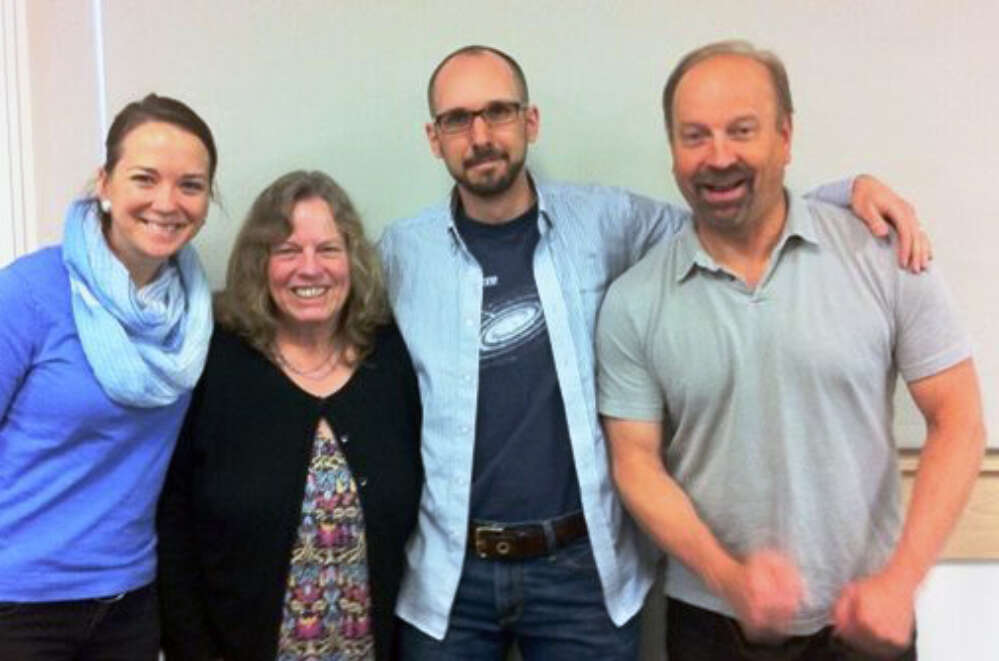The Wrack
The Wrack is the Wells Reserve blog, our collective logbook on the web.
The Wrack is the Wells Reserve blog, our collective logbook on the web.
Two scientists AND their chief salesman want to better communicate coastal science and our changing world, BUT they need some help. THEREFORE, they sought out a guru.

Science is great at figuring out our complex world, and figuring out our complex world is really helpful. But scientists are really not great at communicating their findings. It’s a fundamental weakness in the entire endeavor. Scientists don’t tell good enough stories. Therefore, Dr. Randy Olson, a “reformed" scientist turned filmmaker turned science communications guru, is offering a solution.
Dr. Olson was a marine biologist by training with a tenured position at the University of New Hampshire and, by many measures, he had “made it” in academia. But something was bothering Randy. His grantwriting felt more and more incomprehensible; his research efforts weren't getting the attention he thought his subject deserved. (Read his book “Don’t Be Such a Scientist” for the longer story.) Something was wrong, not in the doing of his science but in his communicating about it. Therefore, Randy embarked on a quest that took him to one of the least scientific places on earth: Hollywood.
Randy has spent the second half of his career studying storytelling, through screenwriting, filmmaking (including the acclaimed “Flock of Dodos” and “Sizzle: A Global Warming Comedy”), improv acting, and even a few well-known books on science communication. And he’s managed to get the word out, slowly and effectively, that scientists need to work on their sales and marketing skills as much as they do their data collection. But the world moves fast, and even though Randy has another book due out in September, the need for clear, concise, and compelling messages from the scientific community is fierce and urgent. Therefore, the solutions can’t just come from one man lecturing around the country: they’ve got to come from the acolytes and converts he reaches along the way.
Those acolytes include at least three staff members from the Wells Reserve. Dr. Kristin Wilson, Dr. Chris Feurt, and I were lucky enough to party with the NURDS this weekend. That’s the Northeast Undergraduate Research and Development Symposium, a conference held annually for the past seven years at the University of New England to bring together undergraduate science majors from across the region to present their fledgling attempts at formal scientific research.
And Randy Olson was asked to keynote the conference this past Saturday. The conference organizers understood Randy’s mission enough to know how important it is to expose early scientists, who still have some flexibility in their outlooks, to the power of storytelling. The undergraduate researchers from around New England and Nova Scotia heard Randy’s message. But the 200 new converts are not enough. The stakes are too high to let Randy’s simple message spread at conference speed. Therefore, I’m going to let you in on Randy’s discovery, his secret formula, his three-step plan, his magic cure to the disease that’s ailing science.
Like a scientist, Randy went into the laboratory of his mind to find the answer. He toiled away for years, distilling narratives to their most basic elements. He read Joseph Campbell, talked with screenwriters, researchers, pundits and ad men. And Randy cracked the code. But he had to learn something that most of us don’t bother to notice: stories are only interesting when they involve tension. Tension arises most easily when a routine, a.k.a. the established order of things, is broken. Therefore, the simplest, fastest way to 1) establish a routine, 2) break it, but then 3) resolve it, is Randy’s ABT Formula:
AND -> BUT -> THEREFORE.
ABT.
See above for my clumsy attempts at using this new template. Try it out yourself and see how quickly you can start summarizing even the most complex problems.
Be clear, concise, and compelling, we’re always told. But how? Now there’s an answer: use the ABT. Set up your initial condition, raise a problem or an issue, and then conclude by explaining what you’ve done to address it. It’s an unbeatable scaffolding for communicating science, or even just telling a good story. Construct your narratives, your abstracts, your elevator speeches, your grant requests in that basic pattern and you CANNOT FAIL to hook your audience, amass vast wealth, and even change the world. I can think of no better lesson to impart to young scientists, just starting out on their heroic quests to better understand our Universe. (Older scientists can benefit from the ABT too.)
"Nothing in biology makes sense except in the light of evolution," wrote evolutionary biologist Theodosius Dobzhansky. Nothing in narrative makes sense except in the light of the tension and resolution encapsulated in the ABT, Randy Olson might reply.
Read more about Randy’s work on his blog, thebenshi.com, and look for his next book, “Houston, We Have a Narrative,” coming this September to, among other places, a national estuarine research reserve near you.
[NC 3/10/15: More on the ABT from the creators of "South Park" can be found here.]